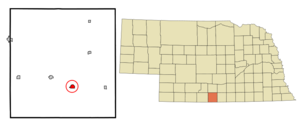- Alma, Nebraska
Infobox Settlement
official_name = Alma, Nebraska
settlement_type =City
nickname =
motto =
imagesize =
image_caption =
image_
imagesize =
image_caption =
image_
mapsize = 250px
map_caption = Location of Alma, Nebraska
mapsize1 =
map_caption1 =subdivision_type = Country
subdivision_name =United States
subdivision_type1 = State
subdivision_name1 =Nebraska
subdivision_type2 = County
subdivision_name2 = Harlan
government_footnotes =
government_type =
leader_title =Mayor
leader_name = Hal Haeker
leader_title1 =
leader_name1 =
established_title =
established_date =unit_pref = Imperial
area_footnotes =
area_magnitude =
area_total_km2 = 1.8
area_land_km2 = 1.8
area_water_km2 = 0.0
area_total_sq_mi = 0.7
area_land_sq_mi = 0.7
area_water_sq_mi = 0.0population_as_of = 2000
population_footnotes =
population_total = 1214
population_density_km2 = 673.6
population_density_sq_mi = 1744.7timezone = Central (CST)
utc_offset = -6
timezone_DST = CDT
utc_offset_DST = -5
elevation_footnotes =
elevation_m = 602
elevation_ft = 1975
latd = 40 |latm = 6 |lats = 3 |latNS = N
longd = 99 |longm = 21 |longs = 45 |longEW = Wpostal_code_type =
ZIP code
postal_code = 68920
area_code = 308
blank_name = FIPS code
blank_info = 31-00975GR|2
blank1_name = GNIS feature ID
blank1_info = 0826967GR|3
website =
footnotes =Alma is a city in Harlan County,
Nebraska ,United States . The population was 1,214 at the 2000 census. It is thecounty seat of Harlan CountyGR|6. The town is named after a daughter of one of the early settlers.The community of Alma emphasizes the opportunities for outdoor activities near the city.
Geography
Alma is located at coor dms|40|6|3|N|99|21|45|W|city (40.100733, -99.362618)GR|1.
Accccording to the
United States Census Bureau , the city has a total area of 0.7square mile s (1.8km² ), all of it land.Alma is located at the junction of US Route 136 and US Route 183. The community is at the northwest end of
Harlan County Lake .Demographics
As of the
census GR|2 of 2000, there were 1,214 people, 520 households, and 318 families residing in the city. Thepopulation density was 1,744.7 people per square mile (669.6/km²). There were 594 housing units at an average density of 853.7/sq mi (327.6/km²). The racial makeup of the city was 99.18% White, 0.08% Native American, 0.08% Asian, 0.08% from other races, and 0.58% from two or more races. Hispanic or Latino of any race were 0.58% of the population.There were 520 households out of which 25.6% had children under the age of 18 living with them, 54.0% were married couples living together, 5.0% had a female householder with no husband present, and 38.8% were non-families. 36.3% of all households were made up of individuals and 22.7% had someone living alone who was 65 years of age or older. The average household size was 2.23 and the average family size was 2.93.
In the city the population was spread out with 24.3% under the age of 18, 3.4% from 18 to 24, 19.8% from 25 to 44, 23.9% from 45 to 64, and 28.7% who were 65 years of age or older. The median age was 46 years. For every 100 females there were 83.9 males. For every 100 females age 18 and over, there were 82.3 males.
The median income for a household in the city was $27,315, and the median income for a family was $36,250. Males had a median income of $26,786 versus $17,065 for females. The
per capita income for the city was $14,795. About 9.5% of families and 13.1% of the population were below thepoverty line , including 17.5% of those under age 18 and 10.0% of those age 65 or over.History
Alma was founded in the spring of 1871 by a group of
Union Pacific railroad laborers originally fromCheyenne, Wyoming . Harlan County was created by theNebraska Legislature on June 3, 1871, and Alma was made the county seat on July 3, 1871. A dispute among the original settlers led to a dissolution of the town, but it was re-organized in 1874.Alma's status as county seat was challenged by residents of Orleans, but an 1884
Nebraska Supreme Court decision affirmed Alma's status as seat of Harlan County. Alma officially incorporated in July 1881.On January 13, 1880 the Burlington Railroad reached Alma, providing a significant boost for local commerce and industry. In 1887, the
Kansas City and Omaha Railroad also reached Alma. Telephone service reached Alma in June 1899.Electricity arrived with a steam power plant in 1906 and water service followed in 1907.In 1935, major flooding of the nearby
Republican River provided an impetus to build a dam on the river. TheArmy Corps of Engineers started construction of the Harlan County Dam on August 1, 1946, and completed work in November 1952. The newartificial lake , Harlan County Lake, became one of Alma's top recreation destinations.During
World War II , Alma hosted a small number of captured German soldiers.References
* Flasnick, Bob, editor (1992). "Alma: Towards the Year 2000". Harlan County Journal.External links
* [http://www.ci.alma.ne.us/ Weblink to Alma]
* [http://www.harlanlake.com/ Harlan County Lake]
* [http://www.almalibrary.com/ Hoesch Memorial Public Library]
* [http://www.harlan.unl.edu/ University of Nebraska-Lincoln Extension in Harlan County]
Wikimedia Foundation. 2010.


